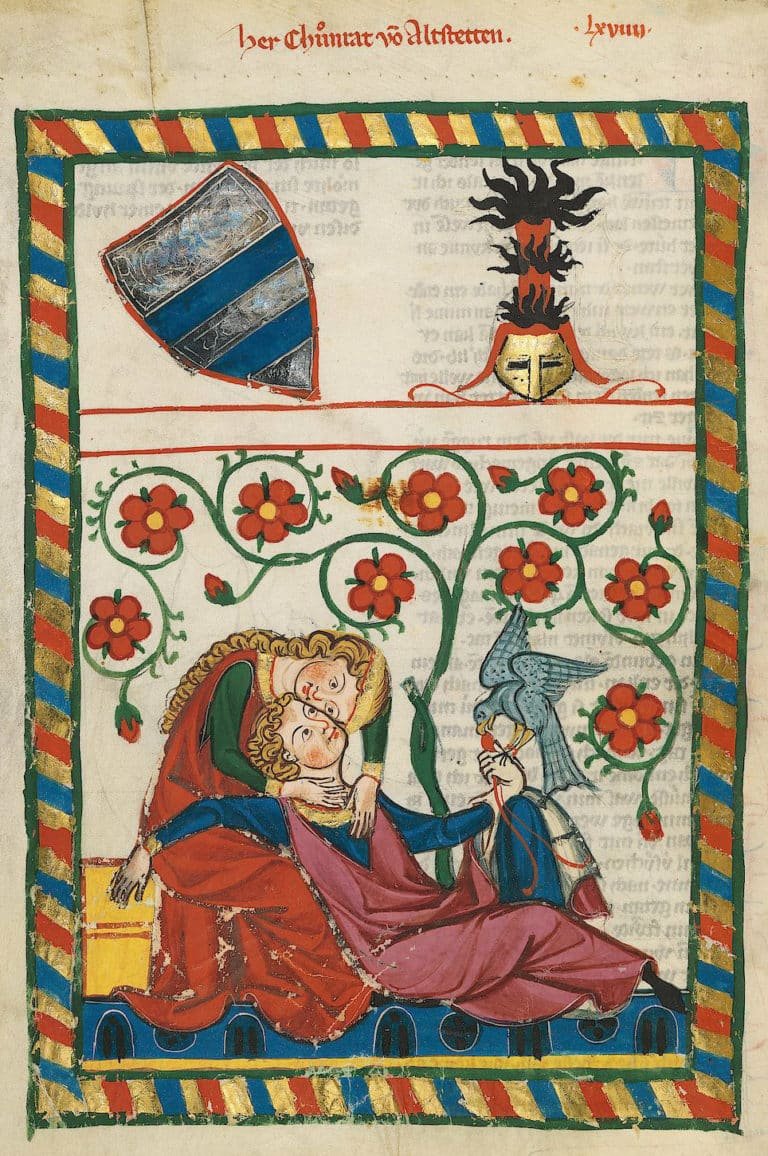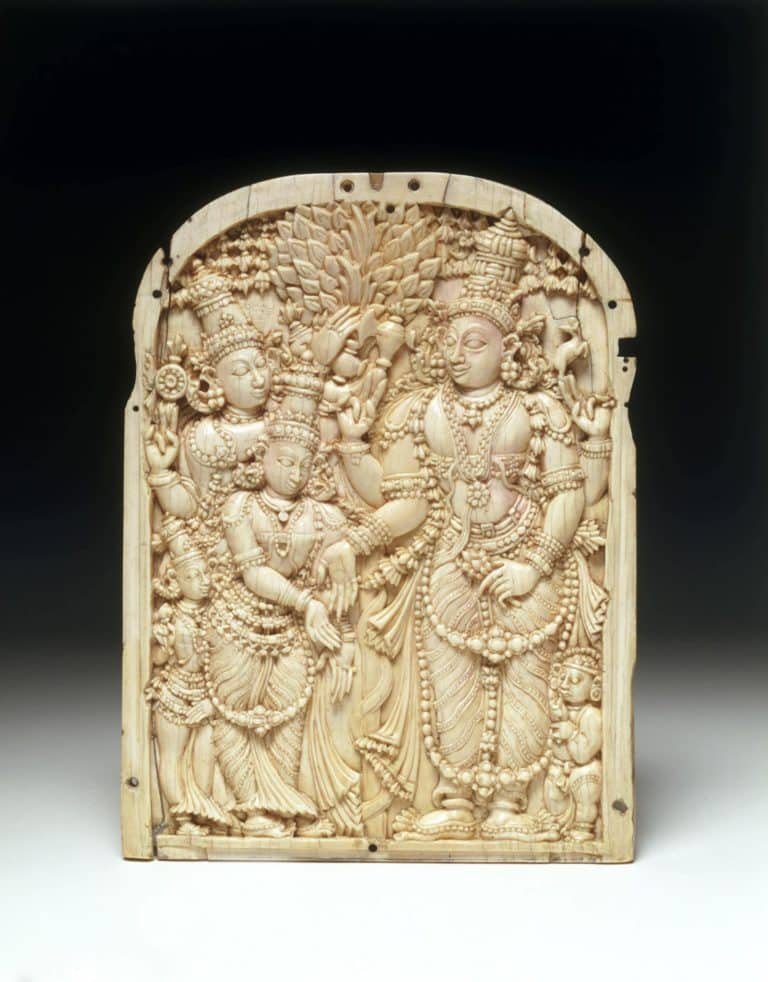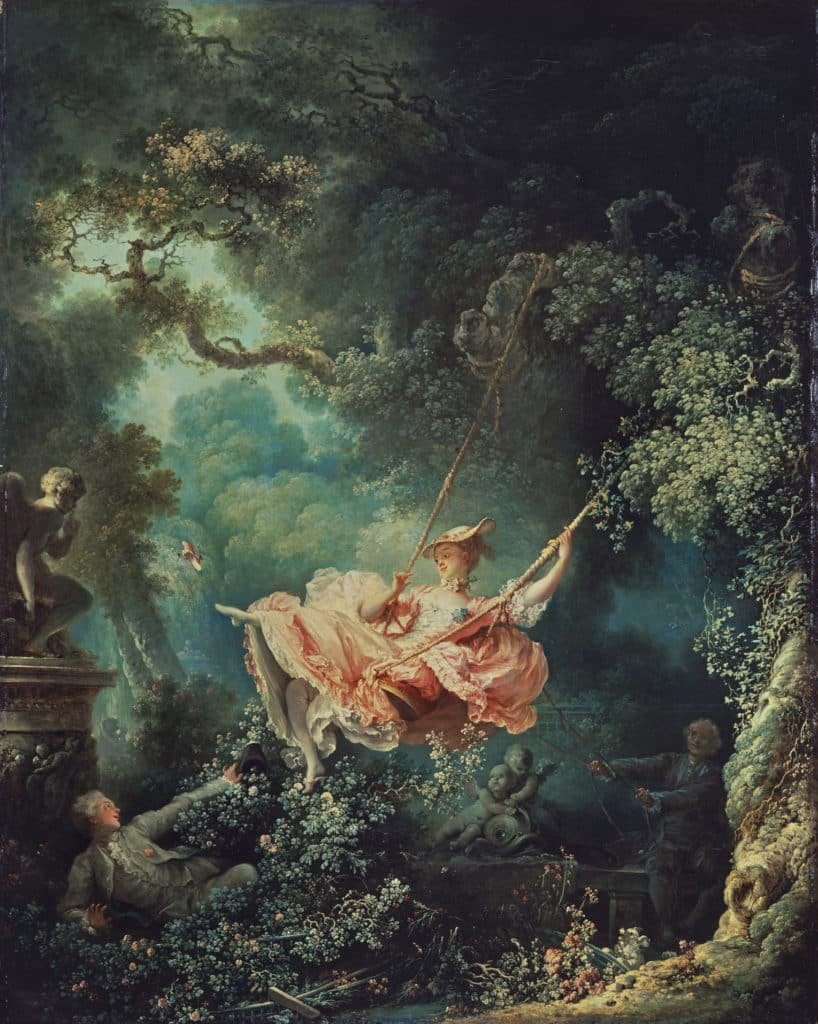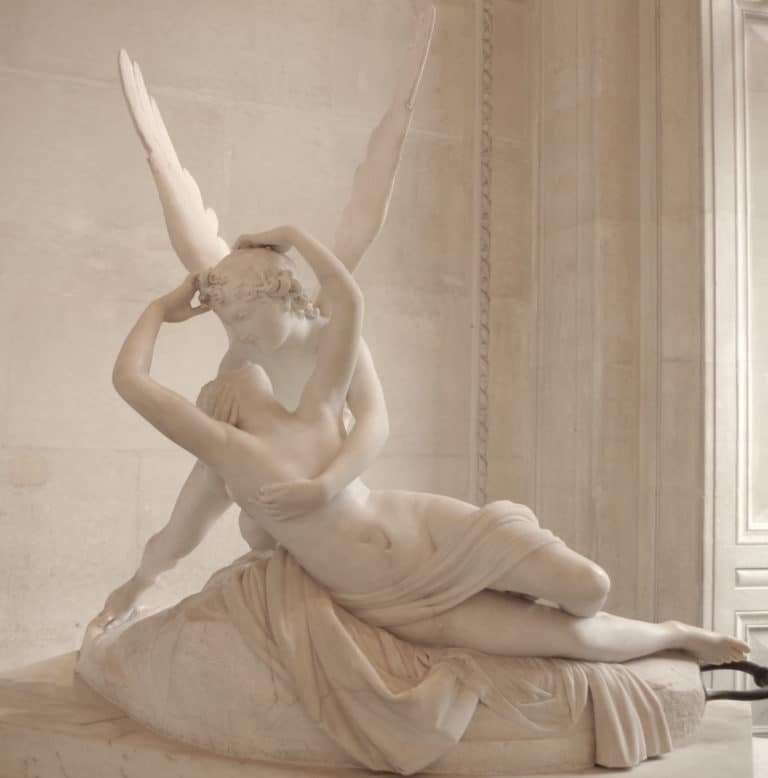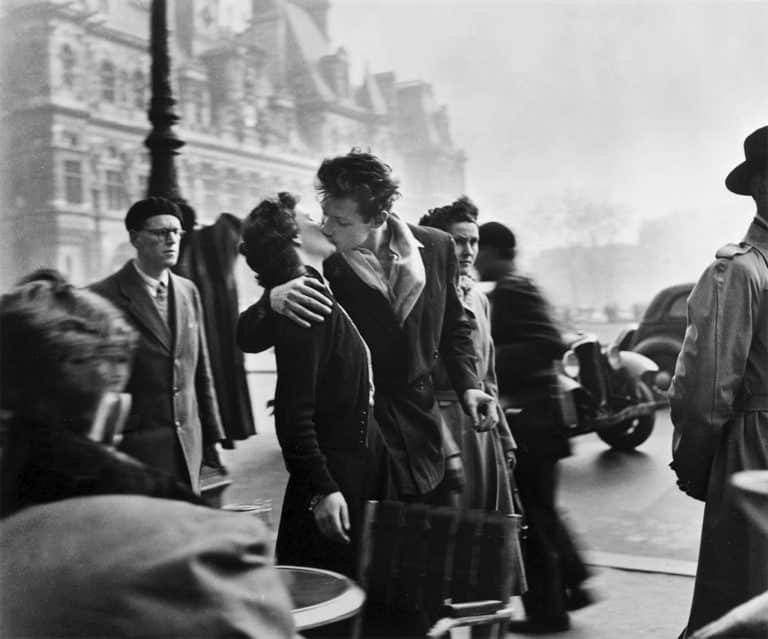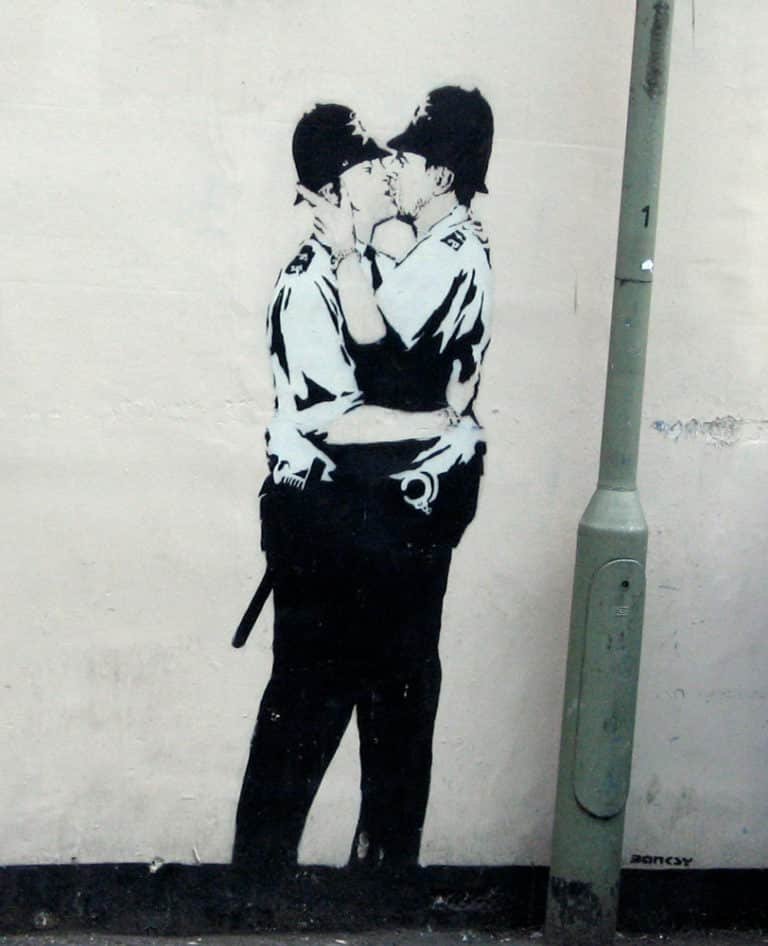Although the origins of Valentine’s Day remain somewhat unclear, they seem to correspond to the Lupercalia, a pagan festival celebrated in ancient Rome between the 13th and the 15th of February. The event was subsequently transformed into a commemoration of Saint Valentine, a bishop famed for conducting wedding ceremonies for young lovers in secret. However, the association with February 14th seems to date back to 14th century England and Geoffrey Chaucer’s Parlement of Foules in which he describes a group of birds which gather together on Saint Valentine’s day to choose their mates for the year. Join me in a journey through the centuries in admiration of ten works of art that celebrate Love!
1. Marital bliss in Ancient Egypt : Statue of Horemreb and his wife, 1300 - 1250 BC.
This double-statue dates from the New Kingdom and is one of the jewels in the British Museum’s Egyptian collection. Husband and wife are seated upon chairs with lion’s claw feet. The sophisticated nature of their wigs and clothing (he wearing a generously-sleeved tunic, loincloth and sandals, she a flowing garment knotted under the chest) enable the work to be dated to the end of the 18th or the beginning of the 19th dynasty, and confirm the subjects as belonging to the aristocracy.
Despite the excellent condition of this sculpture, the identity of the subjects remained a mystery for many years. It was, paradoxically, the absence of hands belonging to the female figure which led to their identification. In 1976 a team of British and Dutch archeologists discovered a fragment of sculpture corresponding to three intertwined hands in the funeral chamber of pharaoh Horemheb. In 2009, a mould taken from the fragment confirmed that the hands belonged to the statue held in the British Museum.
The couple are Horemheb, former Commander in Chief of pharaoh Tutankhamun’s army, and his wife Amenia. The original placement of the hands is, in fact, central to the emotional value of the work in that Amenia was holding her husband’s hand in both of hers. The tenderness this rather unusual gesture displays is what makes the sculpture so very touching.
Our Egyptian couple went on to inspire British sculptor Henry Moore to create his own King and Queen (1952-1953).
2. Courtly love in the Middle Ages: Codex Manesse, 1310-1340
In the Middle Ages, the art of love was codified by a set of rules which inspired of host of literary and artistic representations. Courtly love referred to a way of cherishing one’s true love with respect, honesty… and of course courtesy. This was particularly in vogue during the 12th and 13th centuries, throughout Europe.
The Codex Manesse is one of the most famous of these works. It gathers together songs of courtly love in medieval German composed by some 140 Minnesänger, or troubadours. These texts were compiled and illustrated in Zürich at the beginning of the 14th century, most probably at the request of the Manesse family.
This plate represents Konrad von Altstetten who worked as steward to the abbot of Saint-Gall. The upper part of the illumination displays Konrad’s shield and helm. The astonishingly intimate scene shows the troubadour reclining in the arms of his beloved, a beautiful damsel with long blond hair.
The lovers are affectionately embracing, cheek to cheek. They appear to be in a garden, surrounded by the undulating branches of a rose displaying both flowers and buds, a symbol of their burgeoning romance… As for Konrad, he had doubtless returned from the hunt since his gauntleted hand is holding a falcon – perhaps a way of suggesting his bridled ardour.
3. Passion bridled by love? Alessandro Allori, Venus disarming Cupid, post 1570
You are doubtless familiar with Venus, the Roman goddess of love and beauty. This picture shows her fully-reclined upon some elegant blue drapery. But far from being limited to the role of a languishing muse, here she is reprimanding her son Cupid… The latter, frequently associated with images of Valentine’s Day, has had his bow and arrows confiscated, shielding prospective loving couples from his aim and sting.
The love-related theme is continued by the two turtle doves in the foreground, locking beaks among the roses. As for the golden orb, this is none other than the golden apple gifted to Venus by Trojan prince Paris upon declaring her the most beautiful, to the detriment of both Juno, wife of Jupiter, and Minerva, goddess of wisdom and war. The background is somewhat more discreet: a rabbit, symbol of voluptuousness, can be seen at the feet of Venus, together with a couple running headlong into the lair of Vulcan’s forge, a reference to Hades. Venus seems to be advocating moderation in matters of love…
Alessandro Allori is the artist, a disciple of Bronzino, representing the Florentine mannerist movement. This is reflected in the elongated proportions of the body and the sensitive rendition of the musculature, inherited from Michelangelo. Allori may in fact have based himself on a prototype of Venus disarming Cupid by Michelangelo. The enamelled appearance of the painting, together with the coldness of the lighting are however characteristic of Bronzino, and underline the moralising content of the painting, which nevertheless once belonged to Philippe of Orléans (1674-1723), the Prince Regent, who was renowned for his dissolute morals…
4. The sacred union of masculine & feminine principles: The Marriage of Shiva and Parvati, 1766.
The wedding of Shiva and Parvati, with Vishnu and Lakshmi as witnesses, is carved upon a plate of ivory which may have formed part of a jewellery box. This iconography is very popular in Southern India and is referred to as Kalyanasundara in Sanskrit. The relief is probably linked to the Great temple of Madura which celebrates the sacred union every year.
The divine couple is in reality a metaphor for the union of masculin and feminine principles which, according to Hindu cosmology, are the foundation of the universe. Parvati, the goddess of love and fecundity, counterbalances the unbridled and potentially destructive passion of Shiva.
At the heart of this prolific composition are many interconnected details. Shiva holds his right hand out to that of Parvati. Both cup their palms to receive the sacred liquid poured by Vishnu at the time of their union. The bejewelled bride and groom are wearing tall crowns known as jatamakutas. Shiva is holding a large floral tribute in his left hand… destined perhaps for Parvati ?
You may have noticed Shiva’s second pair of hands? He is holding two of his attributes: the mriga or deer on the left, and his parashu (axe of war) on the right. A gana is standing to his left, a dwarf member of his cortege.
5. The Rococo love triangle : Jean-Honoré Fragonard, The Swing, 1767-1768.
The origins of the painting The Swing are somewhat savoury: an anonymous member of the Court is supposed to have asked the historical painter Gabriel François Doyen to paint him hidden in the bushes, admiring his mistress on a swing while being pushed by a bishop. Doyen having refused, Jean-Honoré Fragonard accepted the sultry commission.
We discover a young woman in an elegant lace-trimmed dress, effectively at the top of a love triangle situated in a garden full of sensually luxuriant vegetation. A courtesan is lying in the bushes gazing at the forbidden sight, while an older man is seen pushing the swing.
Answering the libertine inspiration of his patron, Fragonard produced a composition both dynamic and full of movement. The young woman’s dress floats in the air, as does her shoe, depicted in full flight. The artist’s style reflects this lightness with free, energetic brushwork.
Although the morals of the time allowed men to have mistresses, it was only acceptable for a woman to have a lover providing she had already born her husband a son, and on condition of absolute discretion on her part. Perhaps this is why the sculpture on the left, inspired by Falconet’s Threatening Love, seems to call for our silence. As for the swing, which elevates the young woman to a position of universal lust, does it suggest that her heart is swinging between the two men at her feet, or rather that her precarious position could yet prove to be detrimental?
6. Challenged and rekindled love: Antonio Canova, Psyche revived by Cupid's Kiss, 1787-1793.
A mere twenty years after Fragonard, Cupid once again, also known as Amor or Eros. This masterpiece from the Louvre Museum, created by Antonio Canova at the end of the 18th century, isa scene much inspired by the Antiquity. The story of Cupid and Psyche is told by the Roman author Apuleia and attributed to Plato.
Psyche was a princess whose beauty surpassed even that of the goddess Venus. The latter was so terribly jealous that she asked her son Amor to arrange for Psyche to fall in love with a repulsive monster. Meanwhile, an oracle advised Psyche’s parents to abandon her to her fate. But Zephyr, the god of wind saved her and carried her off to a wonderful palace. Every night, in absolute darkness, Cupid, who had fallen in love with Psyche, met with her, on the understanding that she would not seek to know his identity. But eventually Psyche did bring a candle to reveal her lover’s features and Cupid fled in confusion.
Psyche yearned fervently for her beloved, but the still angry Venus held her in check with numerous impossible challenges. Thanks to the intervention of various divinities, she nevertheless accomplished them all, even returning from the underworld with a flask containing the secret of Proserpine’s beauty. However, she succumbed to her curiosity and opened the flask which in fact contained a poison that caused her to fall into an eternal sleep.
Canova chose to immortalize the moment when Cupid, having set off on a quest to find Psyche, eventually discovers her and manages to revive her with a kiss. The scholarly composition is triangular in shape and spirals upwards to focalize the viewer’s attention on the ballet created by the arms and the faces drawing closer in anticipation of a long-awaited kiss. Cupid’s wings form a final triangle which lends balance to the sculpture as a whole.
7. Resting after love: Henri de Toulouse-Lautrec, In the bed, 1893.
Henri de Toulouse-Lautrec was born into an aristocratic family in Albi, southern France, and at the age of 17 decided to move to Paris to become an artist. His works chronicle the nightlife in Paris at the time of the Belle Époque, and in particular inside the houses of ill-repute. He managed to insinuate himself into the private lives of the prostitutes in whom he inspired confidence, and produced paintings that were both moving and affectionately executed.
In the Bed depicts two women lying facing one another and gazing lovingly into each other’s eyes. The typical Toulouse-Lautrec graphic brushwork lend vibrancy to the scene, despite its stillness. Wrapped in their bed-covers, their heads framed by the whiteness of the pillows, they are isolated from the world that surrounds them. Their silence, however, carries the echo of the emotions that move them. The warmth of the scene is also reflected in the colour palette.
This work is one of a series of four showing different moments in a tender embrace shared by two young prostitutes. The subject matter is always closely framed, focalising the viewer’s attention on the love shared by the two protagonists. Despite being in close proximity, we remain discreetly apart without disturbing the intimacy of the scene.
Is this a languorous moment after making love, as suggested by the pinkness of the cheeks, ears and lips? Or perhaps a tender morning awakening?
8. Between passion and doubt: Gustav Klimt, The Kiss, 1908.
Gustav Klimt and The Kiss transport us into a world of dreams. The form of two lovers clasped in a tight embrace emerges against a resplendent golden background, placed upon a carpet of flowers. Their heads are pressed tightly against the upper edge of the canvas, but their uncertain equilibrium seems to have them teetering above a precipice. Are they about to lose their footing?
The man is probably Klimt himself, together with Emilie Flöge, his artistic muse. Although she hailed from a respectable middle-class family, she chose not to marry in order to pursue a successful career in fashion design. But the physical response of the woman to the enthusiastic embrace by her lover betrays noticeable resistance… She seems to be curling her toes and her face, though serene, is slightly turned away, as though in doubt.
Nevertheless, there is no denying the osmosis in this opulently furnished canvas, lending visual unity to the lovers despite the decorative motifs of the clothing which differentiate the two subjects. The man’s clothing is decorated with vertical rectangular shapes whereas that of the woman has coloured circular and ovoid motifs.
Gustav Klimt’s The Kiss is the final work from his Golden Phase which lasted for ten years. The decorative aspect of this work, which is characteristic of the Vienna Secession but was also influenced by Byzantine mosaics seen by the artist in Venice, lends a universal dimension to this couple, drawn between passion and restraint.
9. Love in romantic Paris: Robert Doisneau, Le Baiser de l’Hôtel de Ville, 1950.
This famous photograph, which has been reproduced countless times, has become a visual paradigm for Love in Paris. But did you know that this supposedly “stolen” snapshot had in fact been totally stage-managed with the help of two theatre students?
Robert Doisneau was a humanist photographer, and as such sought to immortalise moments and emotions from everyday life. In 1950, the American magazine Life commissioned him for some photographs on the theme of Love in Paris. At the time, however, it was far less usual to see couples kissing in the street than it is today. So Doisneau decided to call upon the services of two acting students, but who were actually dating, and got them to pose in different parts of Paris. The Hôtel de Ville was the location chosen for the final photograph.
The viewpoint adopted by the photographer is that of a customer sitting on the terrace in front of a café, such as the man seen in the bottom left-hand corner of the composition. This enables Doisneau to create the impression of an impromptu snap, with the spectator witnessing two lovers engaged in a passionate kiss. There is only the woman behind the student actor whose glance seems to suggest the presence of the photographer and clashes with the impression of spontaneity.
What has made this image iconic is the contrast between the couple who are stationary and several passers-by who are walking towards them from behind. Time seems to have stopped for the moment of the kiss. Finally, Robert Doisneau focusses the shot on the two lovers, alone in their bubble, while everything that surrounds them remains a blur.
10. Love (and Street Art) heals the world : Banksy, Kissing Coppers, 2005
Kissing Coppers is one of Banksy’s most famous works. Banksy is a world-renowned street artist, but keeps his identity a secret, although he is thought to be a man from Bristol, born about 1974. The painting, produced using stencils, was first noticed in 2005 on a pub wall in the seaside town of Brighton in southern England.
Two British policemen are exchanging a passionate kiss. The scene appears discordant, but Banksy often uses subversive images that make people smile as a way of getting more serious messages across.
This wall painting would appear to be an appeal for tolerance with regard to sexual orientation. Here the artist is using representatives of public order as figureheads for the gay community.
Banksy’s decision to use officers in uniform and not in civilian dress is all the more interesting as Street Art still remains against the Law. Some believe he was making fun of the forces of law and order. However the work seems more likely to be a desire to humanise policemen, by situating them on the side of social progress and revealing signs of tenderness which are rarely associated
with the profession.


